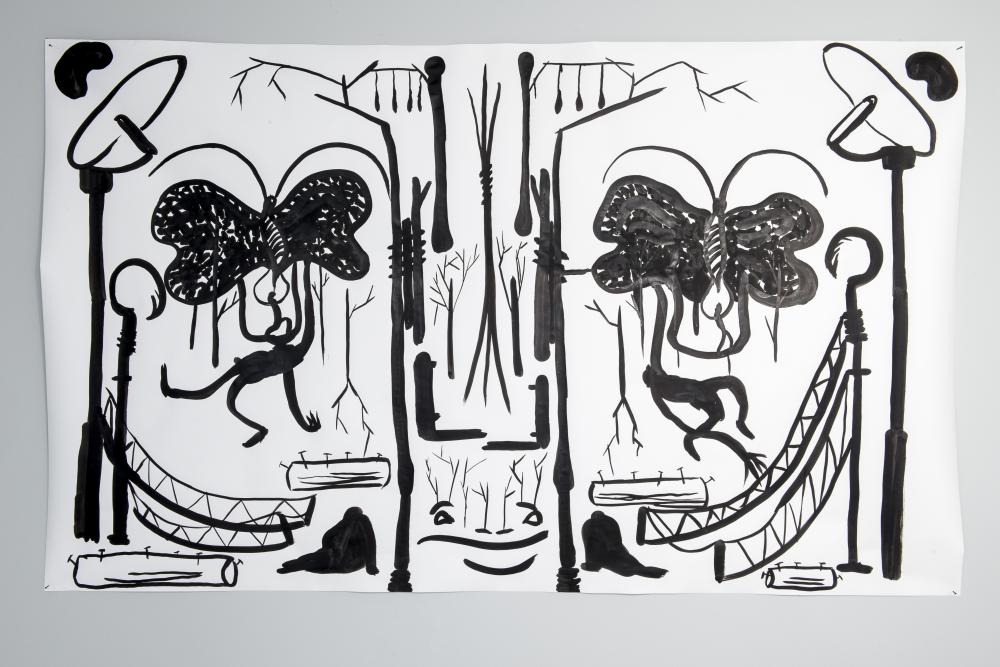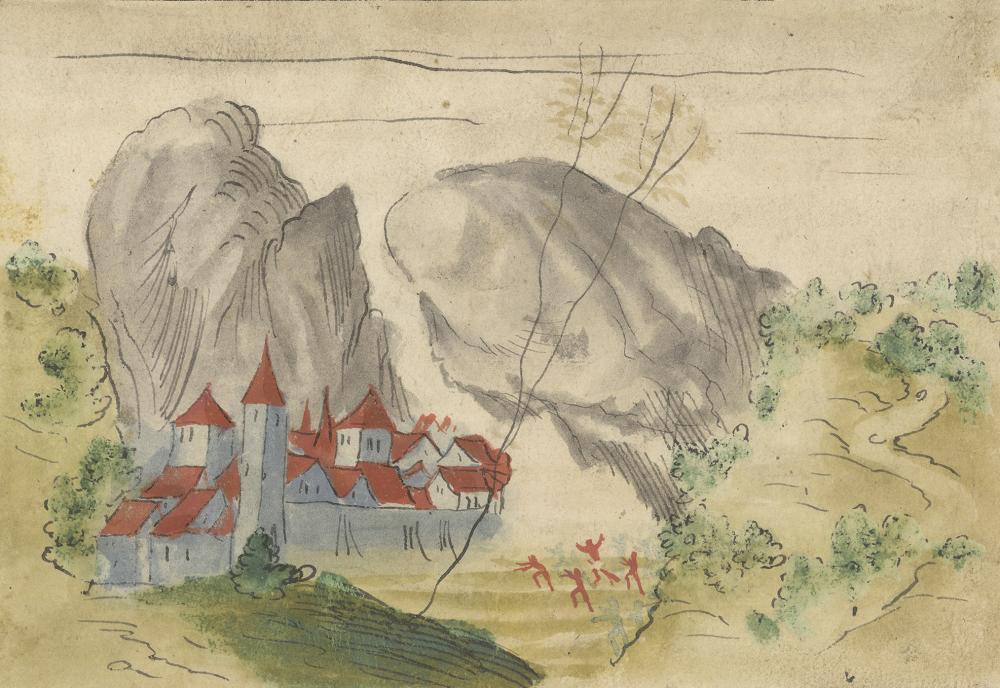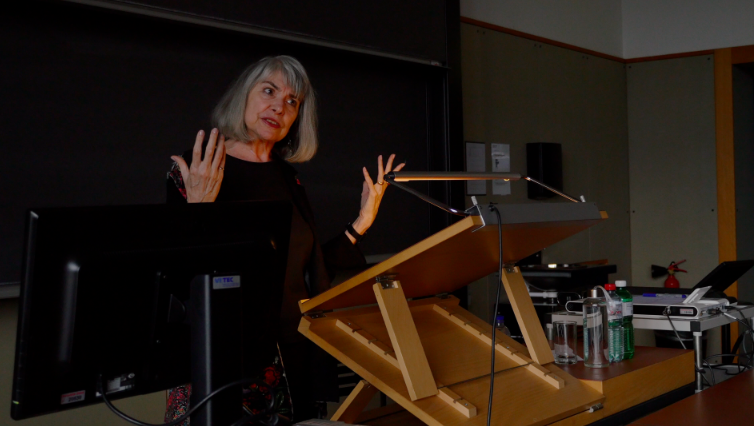Münster – A Giant’s Tale


The beam as agency or object? Beaming with apocalypse just as beaming with joy, just as a beam of apocalypse carrying a building, or been built upon, or even beaming the apocalypse up to Scotty, or is that where it all came from? This could be the question posed by this Focus Strahlen der Apokalypse (Beaming Apocalypse); posed to you, the readers, and to us, the curators and authors of the contributions. It is a question that strikes at the turbulent heart of the apocalypse: while its weighty, primarily religiously defined historicity today appears mainly objectified in artefacts and discourses, its current topicality is based, above all, on its continuing agency. Apocalypse is first and foremost a vision for the future. Accordingly, the beam we are talking about here is a vector, a movement in the various meanings of the word: physical and spiritual, social and political movement. The pieces contributed to this Focus are therefore fundamentally prismatic. We view them as a preliminary review of Die Stral, our publication, exhibition and event project on the subject of the apocalypse one year ago at the University of Zürich in cooperation with the ZH Reformation anniversary festival. The pieces assembled in this Focus reflect a large part of those debates, as we combine lecture manuscripts revised especially for this purpose with additional contributions and make them available online for the first time. New contributions add to and expand the ongoing discussion.
 Wickiana, Zentralbibliothek Zürich, Handschriftenabteilung, Ms. F 12, 116r
Wickiana, Zentralbibliothek Zürich, Handschriftenabteilung, Ms. F 12, 116r
447 years ago, in the year 1572, the sky over Zürich unloaded and lighting struck the Grossmünster church, the epicenter of the Zürich Reformation. The weather was interpreted, its interpretation discussed, the news spread. The correspondence of the Reformer Heinrich Bullinger offers insights into the Europe-wide news network of the time. It shows, for instance, how weather events affected communication, society and faith in the context of a changing climate and sectarian conflicts at the time, how they were perceived as alarming and, indeed apocalyptic. Unlike Huldrych Zwingli, who was skeptical towards the Book of the Apocalypse and its socio-political utilization, his successor, Bullinger, studied it intensely, including in his A Hundred Sermons upon the Apocalypse of Jesus Christ (1554–56). Since then, the biblical theme of the end of days has lost little of its relevance. On the contrary: due to renewed climate changes, social and religious conflicts and their dissemination through the media, the end of the world is experiencing a boom again. But what does this say about the 2000-year-old book? How did its ideas travel across geographies and history (or histories), and what purpose did it serve then and now in its reactivated form? How then does the interleaving of natural phenomena, contemporary events and vision for the future that is inherent to the narrative of apocalypticism release collective social and individual psychic forces?
In Die Stral, an exhibition by Zürich-based artist Florian Germann, the image of the lightning strike is conceived differently. It deliberately contradicts subject-centered concepts, because Germann’s installation also introduces agents other than human ones as well as processes, thereby reconfiguring our view of past and present. The installation implicitly requires us to reflect on how we relate to the weather and other physical, non-human processes – in other words, phenomena that are an integral part of everyday life, that affect it and yet are easily forgotten. Especially today, in the awareness that our species has become a factor affecting biological, geological and atmospheric processes, we are increasingly – and on a catastrophic scale – reminded of it. Despite this crisis-like outlook, the exhibition in the University of Zürich’s Foyer West also had a grounding effect as a result of the meeting and dialog of book and installation. Perhaps, looking back on a stressful yet hopeful time enables a new perspective on the relative proportion of social, geopolitical and natural forces today.

Wickiana, ZBZ, Handschriftenabteilung, Ms. F 19, 243r-243v

Wickiana, ZBZ, Handschriftenabteilung, Ms. F 16, 155v-156r
Apocalypse After All? was the first question we asked in the Die Stral program of events in May, a week after the exhibition opening. More specifically, we asked American philosopher and theologian Catherine Kellerthis question, and she posed it back to us. We gave this evening lecture at the University of Zürich the subtitle A Theopoetics of Planetary Crisis to convey the interplay of ecological and gender politics, process cosmology, poststructuralist philosophy and religious pluralism that characterizes Keller’s work. Based on her 1996 book Apocalypse Now and Then: A Feminist Guide to the End of the World, Keller presented the biblical narrative of the end of days in detail and described in highlights its resurgence in protestant fundamentalisms and political nihilisms of the present, notably in the U.S. Revised especially for this Focus, her lecture manuscript shows Keller countering this development with an alternative political theology, what she calls an «ecofeminist theopoetics», which seeks openness rather than isolation and replaces the desire for redemption through cataclysm with a notion of catalysis, i.e. triggering.
And then there is Münster, one of the key locations of the Protestant Reformation in the German-speaking world, particularly of the apocalyptic argumentations of the Anabaptists. It is also one of the main settings of the historical thriller Q (1999) by the Italian collective Luther Blissett, which was the focus of the second Die Stral event. We read excerpts from the novel which covers forty years of reformatory turmoil. Written partly in the form of letters, this artistic collective textual work presented itself to us as an illuminating example of contemporary adaptations of the historical events in question that perfectly aligns itself with our interest in the correspondence of Zürich Reformer Heinrich Bullinger. A group of younger artists and cultural workers – the curators Arthur Fink, Daniel Morgenthaler and Ludovica Parenti as well as the artists Michèle Graf and Miriam Laura Leonardi and the artist and art historian Andreas Selg – read, selected, rehearsed and presented the lines. The reading at the Wasserkirche church on the banks of the Limmat was set to experimental, organ-like electronic music by MOOON duo (Emanuel Rossetti and Rafal Skoczek), thus making for an evening that defied documentation in sounds, pictures or words alone. Looking back, we direct our attention instead to present-day Münster and, more specifically, the local Westfälischer Kunstverein. Four years ago, the artist and writer Peter Wächtler produced a 26-minute video for the Kunstverein by reading one of his texts and at the same time showing an animated drawing of a sorcerer. Beliefs and superstitions, farewell and welcome, malice and hysteria are woven into a scenario that bears obvious apocalyptic traits. The reprint below of Wächtler’s short story Münster – A Giant’s Tale resonates and reverberates with the abysses of individual joy and sorrow in this day and age.
Further considerations and contributions will follow these three pieces on the Beaming the Apocalypse Focus.

Wickiana, ZBZ, Handschriftenabteilung, Ms. F 22, 688r

Wickiana, ZBZ, Handschriftenabteilung, Ms. F 21, 166r

Wickiana, ZBZ, Handschriftenabteilung, Ms. F 14, 214v

Wickiana, ZBZ, Handschriftenabteilung, Ms. F 14, 215r

Wickiana, ZBZ, Handschriftenabteilung, Ms. F 15, 454r

Wickiana, ZBZ, Handschriftenabteilung, Ms. F 12, 212r

Wickiana, ZBZ, Handschriftenabteilung, Ms. F 19, 110r

Wickiana, ZBZ, Handschriftenabteilung, Ms. F 15, 385r

Wickiana, ZBZ, Handschriftenabteilung, Ms. F 18, 159r

Wickiana, ZBZ, Handschriftenabteilung, Ms. F 16, 155v-156r

Wickiana, ZBZ, Handschriftenabteilung, Ms. F 17, 274r

Wickiana, ZBZ, Handschriftenabteilung, Ms. F 14, 69v
Strahlen als Aktivität oder als Sache? So könnte die Frage dieses Fokus’ lauten. Denn der Titel Strahlen der Apokalypse lässt es offen: Das Strahlen der Apokalypse oder Die Strahlen der Apokalypse? Somit ist er Titel und zugleich Frage: eine Frage an euch, die Leser*innen, sowie an uns, die Kurator*innen und Autor*innen der Beiträge. Sie trifft damit den turbulenten Kern der Apokalypse: Während ihre schwergewichtige und vor allem religiös bestimmte Geschichtlichkeit uns heute vorwiegend in Artefakten und Diskursen versachlicht erscheint, ist ihre gegenwärtige Aktualität vor allem durch ihre fortwährende Aktivität begründet. Denn Apokalypse ist in erster Linie Zukunftsentwurf. Und so ist der Strahl, um den es hier geht, ein Vektor: eine Bewegung im mehrfachen Sinne von physischer und geistiger sowie gesellschaftlicher und politischer Bewegung. Die Beiträge dieses Fokus’ sind daher prinzipiell prismatisch. Wir verstehen sie als vor-läufigen Rück-blick auf unser Publikations-, Ausstellungs- und Veranstaltungsprojekt Die Stral zum Thema der Apokalypse an der Universität Zürich und in Zusammenarbeit mit dem Jubiläumsfestival ZH Reformation vor nun etwa einem Jahr. Die in diesem Fokus versammelten Beiträge reflektieren einen Grossteil dieser Diskussionen, in dem wir eigens hierfür überarbeitete Vortragsmanuskripte mit ergänzenden Beiträgen kombinieren und erstmals online zur Verfügung stellen. Neue Beiträge ergänzen und erweitern die bereits eröffneten Diskussionen.

Darstellung des wundersamen Versinkens eines Berges bei Neuenburg am Rhein um Ostern, 1562, Wickiana, Zentralbibliothek Zürich, Handschriftenabteilung, Ms. F 12, 116r
Vor 447 Jahren, im Jahr 1572, entlädt sich der Himmel über Zürich – ein Blitz schlägt in das Grossmünster ein, dem Epizentrum der Zürcher Reformation. Das Wetter wurde gedeutet, die Deutung diskutiert, die Nachricht verbreitet. Der Briefwechsel des Reformators Heinrich Bullinger gibt Einblicke in das europaweite Nachrichtennetzwerk jener Zeit. Er zeigt so zum Beispiel, wie Wetterereignisse im Zuge des damaligen Klimawandels und der konfessionellen Konflikten auf Kommunikation, Gesellschaft und Glaube wirkten: bedrohlich, ja apokalyptisch. Anders als Huldrych Zwingli, der dem Buch der Apokalypse und ihrem gesellschaftspolitischen Gebrauch skeptisch begegnete, beschäftigte sich sein Nachfolger Bullinger intensiv damit, zum Beispiel in seinen 100 Predigten über die Offenbarung des Johannes (1554-1556). Seitdem hat das biblische Motiv der Endzeit kaum an Relevanz verloren, im Gegenteil: Durch neuerliche Klimaveränderungen, soziale und religiöse Kämpfe und ihre mediale Verbreitung hat das Ende der Welt wieder Hochkonjunktur. Was aber besagt sie über das 2000 Jahre alte Buch? Wie durchquerten seine Ideen Geografien und Geschichte(n), und welchen Nutzen hat seine Reaktivierung damals und heute? Wie also setzt die dem Narrativ der Apokalyptik eigene Verschränkung von Naturereignis, Zeitgeschehen und Zukunftsvision gesamtgesellschaftliche und individuelle psychische Kräfte frei?
In der Ausstellung Die Stral des Zürcher Künstlers Florian Germann war das Motiv des Blitzes anders gedacht. Es konterkariert subjektzentrierte Vorstellungen bewusst. Denn Germann führt mit seiner Installation nicht nur menschliche, sondern auch andere Akteure und Prozesse ein, und rekonfiguriert damit unseren Blick auf Geschichte und Gegenwart. Die Installation fordert implizit, über unsere Beziehung zum Wetter und zu anderen physischen, nicht-menschlichen Prozessen nachzudenken. Phänomene also, die integraler Bestandteil unseres täglichen Lebens sind, es beeinflussen und dennoch leicht vergessen gehen. Gerade heute, mit dem Wissen, dass unsere Spezies zu einem Einflussfaktor auf die biologischen, geologischen und atmosphärischen Prozesse geworden ist, werden wir zunehmend und in katastrophalem Ausmass an sie erinnert. Trotz jenes krisenhaften Horizonts hatte die Ausstellung im Foyer West der Universität Zürich auch erdende Wirkung durch das Zusammentreffen dieser beiden, im Dialog stehenden Teile: Buch und Installation. Vielleicht ermöglicht der Blick zurück, auf eine angespannte und doch auch hoffnungsvolle Zeit, eine neue Perspektive auf das gegenwärtige Verhältnis zwischen gesellschaftlichen, geopolitischen und natürlichen Kräften.

«1571. Ein Brief von Herrn Josua Mahler, Pfarrer in Bischofszell, an Herrn Christoph Froschauer. Am 7. Juli schlug der Blitz in Bernhardzell, im Lande des Abts von St. Gallen, nicht weit weg von Bischofszell, in einen Turm, von wo er der Mauer nach in die Kirche, ins Sakrementhäuschen, gelangte. Dort schlug er die Hostie aus der Pyxis [dem Behälter für konsekrierte Hostien] [...]. Aus dem Sakramenthäuschen ging er aber über den Altar, den er samt allen Paramenten [Altardecke usw.] und allen Heiligenbildern zu kleinen Splittern und Stücken zerschlug [...].», Wickiana, ZBZ, Handschriftenabteilung, Ms. F 19, 243r-243v

«1564. Ein Brief von Herrn Johannes Haller von diesem Berg. Vorgestern kamen schreckliche Berichte aus dem Aostatal, wie ein Dorf mit Namen Arras, das eine Viertelmeile von der Stadt Aosta entfernt ist, durch einen Berg, der herabstürzte, ganz und gar verschüttet und jählings zugedeckt wurde, dass keine Spur eines Dorfes mehr da sei. [...]», Wickiana, ZBZ, Handschriftenabteilung, Ms. F 16, 155v-156r
Apocalypse After All? lautete die erste Frage, die wir im Veranstaltungsprogramm zu Die Stral stellten. Genauer gesagt: Wir stellten sie der amerikanischen Philosophin und Theologin Catherine Keller, und die stellte sie uns zurück. A Theopoetics of Planetary Crisis untertitelten wir diesen Abendvortrag an der Universität Zürich, um Kellers typisches Zusammenspiel von ökologischer und Gender-Politik, von Prozess-Kosmologie, poststrukturalistischer Philosophie und religiösem Pluralismus zu vermitteln. Ausgehend von ihrem Buch Apocalypse Now and Then: A Feminist Guide to the End of the World (Die Apokalypse Heute und Damals: Ein Feministischer Führer zum Ende der Welt, 1996) stellt Keller das biblische Narrativ der Endzeit detailliert vor und beleuchtet schlaglichtartig sein Wiederaufflammen in protestantischen Fundamentalismen und politischen Nihilismen der Jetztzeit, besonders in den USA. Ihr eigens für diesen Fokus überarbeitetes Vortragsmanuskript zeigt, wie Keller dem eine alternative politische Theologie entgegen setzt. In ihren Worten: eine «ökofeministische Theopoetik», die Öffnung statt Abschottung (ver-)sucht und das Begehren nach Erlösung durch Katastrophe mit dem Denken der Katalyse, also dem Auslösen, ablöst.
Und dann ist da noch Münster. Einer der Hauptschauplätze der protestantischen Reformation im deutschsprachigen Raum, besonders der apokalyptischen Argumentationen der Wiedertäufer. Einer der Haupthandlungsorte im historischen Thriller Q (1999) des italienischen Kollektivs Luther Blissett, dem wir uns in der zweiten Veranstaltung von Die Stral widmeten. Wir lasen Auszüge aus diesem Roman, der 40 Jahre reformatorische Wirren umspannt. Teilweise in Briefform verfasst, stellte sich uns diese künstlerische kollektive Textarbeit als ein aufschlussreiches Beispiel aktueller Bearbeitungen jener historischen Geschehnisse dar, das ideal an unsere Beschäftigung mit dem Briefwechsel des Zürcher Reformators Heinrich Bullinger anschliesst. Eine Gruppe jüngerer Zürcher Kunst- und Kulturschaffender las, selektierte, probte und präsentierte die Zeilen: die Kuratoren Arthur Fink, Daniel Morgenthaler und Ludovica Parenti sowie die Künstlerinnen Michèle Graf und Miriam Laura Leonardi und der Künstler und Kunstwissenschaftler Andreas Selg. Experimentell, orgelmusikalisch-elektronisch vertont wurde die Lesung in der Wasserkirche an der Limmat vom MOOON Duo (Emanuel Rossetti, Rafal Skoczek) – ein Abend also, der sich weder in Ton, Bild oder Text allein dokumentieren liesse. Rückblickend schauen wir stattdessen ins heutige Münster, genauer: in den dortigen Westfälischen Kunstverein. Für diesen produzierte der Künstler und Schriftsteller Peter Wächtler vor vier Jahren ein 26-minütiges Video, in dem er zu einer animierten Zeichnung eines Zauberers einen seiner Texte gelesen hat. Glauben und Aberglauben, Abschied und Begrüssung, Häme und Hysterie verweben sich zu einem Szenario, das deutlich apokalyptische Züge trägt. Im folgenden Wiederabdruck von Wächtlers Kurzgeschichte Münster – A Giant’s Tale klingen die Abgründe von individuellem Freud und Leid in unserer Zeit an und nach.
Diesen ersten Teilen zum Fokus Strahlen der Apokalypse werden weitere Überlegungen und Beiträge folgen.

Darstellung eines starken Hagelsturms und vom Hagel erschlagener Tiere, Wickiana, ZBZ, Handschriftenabteilung, Ms. F 22, 688r

Darstellung eines ertrinkenden Schweinehirten mitsamt seiner Herde in einem aufgrund von Sturmwetter hochgehenden Bach, Wickiana, ZBZ, Handschriftenabteilung, Ms. F 21, 166r

«Grosse Überschwemmung. Am 7. Juli 1562 am Morgen zwischen drei und vier Uhr kam die Sihl auf einmal gewaltig hoch daher, dass sie alle Dämme brach und die Brücken von Adliswil und Leimbach wegriss. [...]», Wickiana, ZBZ, Handschriftenabteilung, Ms. F 14, 214v

«[...] In der Sihl schwamm eine Kuh hinunter auf einer Schwarzpappel; die führte ihre Futterkrippe am Hals mit sich. Sie wurde bei St. Jakob herausgezogen und konnte fast nicht am Leben erhalten werden.», Wickiana, ZBZ, Handschriftenabteilung, Ms. F 14, 215r

«1563. Welchen Schaden eine Schneelawine am Gotthard anrichtete. Am 13. Dezember fuhr eine Lawine daher und riss 26 Pferde und sieben Männer mit sich und verschüttete sie. Darunter war ein Kaufmann aus Mailand, der mehr als 2000 Kronen mit sich geführt haben soll.», Wickiana, ZBZ, Handschriftenabteilung, Ms. F 15, 454r

Darstellung eines Brandes der St. Pauls-Kirche in London durch ein Blitzeinschlag 1561, Wickiana, ZBZ, Handschriftenabteilung, Ms. F 12, 212r

«1570. Ein Brief des Herrn Landvogt Gimper aus dem Maggiatal von einer grossen Überschwemmung. [...] An unserer Kirchweih hatte ich Gäste, da begann das Wasser zum Hof hineinzulaufen. [...] », Wickiana, ZBZ, Handschriftenabteilung, Ms. F 19, 110r

Oben: Darstellung eines vom Blitz erschlagenen Bauern mit Pflug und Vieh und Sohn; unten links: Darstellung eines Blitzes, der einen Pfarrer von der Kanzel schlägt und weitere Personen trifft; unten rechts: Darstellung mehrerer Blitzeinschläge in Bern, Wickiana, ZBZ, Handschriftenabteilung, Ms. F 15, 385r

Darstellung der vom Blitz erschlagenen Wäscherin Barbara Usteri im Juli 1569 in Zürich, Wickiana, ZBZ, Handschriftenabteilung, Ms. F 18, 159r

«1564. Ein Brief von Herrn Johannes Haller von diesem Berg. Vorgestern kamen schreckliche Berichte aus dem Aostatal, wie ein Dorf mit Namen Arras, das eine Viertelmeile von der Stadt Aosta entfernt ist, durch einen Berg, der herabstürzte, ganz und gar verschüttet und jählings zugedeckt wurde, dass keine Spur eines Dorfes mehr da sei. [...]», Wickiana, ZBZ, Handschriftenabteilung, Ms. F 16, 155v-156r

Darstellung einer grossen Überschwemmung mit Ertrinkenden in Verona im November 1567, Wickiana, ZBZ, Handschriftenabteilung, Ms. F 17, 274r

Grosse Überschwemmung in Salza [heute Langensalza], Wickiana, ZBZ, Handschriftenabteilung, Ms. F 14, 69v

